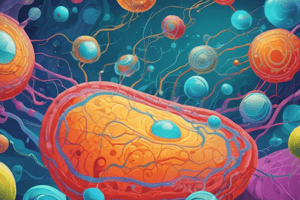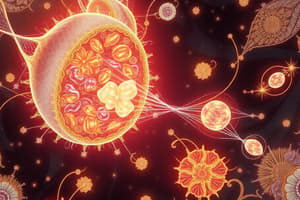Podcast
Questions and Answers
What is the primary function of the internal pressure of water against the cell wall?
What is the primary function of the internal pressure of water against the cell wall?
- To increase cellular metabolism
- To provide structural support to the cell (correct)
- To promote cellular reproduction
- To facilitate enzyme activity
In a 95% NaCl solution, what will primarily happen to the water within the cell?
In a 95% NaCl solution, what will primarily happen to the water within the cell?
- Water will remain at equilibrium
- Water will cause the cell to burst
- Water will move out of the cell (correct)
- Water will move into the cell
What will be the likely outcome for a cell placed in a 95% H2O solution over time?
What will be the likely outcome for a cell placed in a 95% H2O solution over time?
- The cell will maintain its size
- The cell will become turgid and potentially burst (correct)
- The cell will move out of the solution
- The cell will lose water and shrink
What type of transport is represented by the processes shown in the referenced image?
What type of transport is represented by the processes shown in the referenced image?
If a cell is placed in a solution with higher glucose concentration outside than inside, where will the glucose likely move?
If a cell is placed in a solution with higher glucose concentration outside than inside, where will the glucose likely move?
What is the primary purpose of exocytosis in cells?
What is the primary purpose of exocytosis in cells?
What role do docking proteins play in exocytosis?
What role do docking proteins play in exocytosis?
Which process is specifically referred to as 'cell eating'?
Which process is specifically referred to as 'cell eating'?
During endocytosis, what typically happens after a vesicle is formed?
During endocytosis, what typically happens after a vesicle is formed?
Which description accurately defines the phosphate end of a phospholipid?
Which description accurately defines the phosphate end of a phospholipid?
What does pinocytosis refer to in cellular processes?
What does pinocytosis refer to in cellular processes?
Which of the following accurately describes filtration?
Which of the following accurately describes filtration?
What factors influence the rate of diffusion?
What factors influence the rate of diffusion?
What is a characteristic of simple diffusion?
What is a characteristic of simple diffusion?
What characterizes the structure of the plasma membrane?
What characterizes the structure of the plasma membrane?
What process involves the transport of molecules into the cell through vesicles?
What process involves the transport of molecules into the cell through vesicles?
What type of molecules can generally diffuse freely through the plasma membrane?
What type of molecules can generally diffuse freely through the plasma membrane?
What are the energy requirements of processes such as endocytosis and exocytosis?
What are the energy requirements of processes such as endocytosis and exocytosis?
What primarily determines the direction of movement in filtration?
What primarily determines the direction of movement in filtration?
Which of the following substances typically cannot pass through filtration membranes?
Which of the following substances typically cannot pass through filtration membranes?
What initiates the docking process in exocytosis?
What initiates the docking process in exocytosis?
How does exocytosis contribute to cellular waste management?
How does exocytosis contribute to cellular waste management?
What is the relationship between diffusion rate and concentration gradient?
What is the relationship between diffusion rate and concentration gradient?
Why can water pass through the plasma membrane despite being polar?
Why can water pass through the plasma membrane despite being polar?
Which type of endocytosis is characterized by the ingestion of liquid substances?
Which type of endocytosis is characterized by the ingestion of liquid substances?
What best describes osmosis in relation to the cell?
What best describes osmosis in relation to the cell?
What role do proteins play in the plasma membrane?
What role do proteins play in the plasma membrane?
In the fluid mosaic model, what does the term 'fluid' imply about the membrane?
In the fluid mosaic model, what does the term 'fluid' imply about the membrane?
Which of the following substances would most likely require a transport protein to cross the plasma membrane?
Which of the following substances would most likely require a transport protein to cross the plasma membrane?
What is the primary function of active transport in cells?
What is the primary function of active transport in cells?
Which of the following substances is primarily transported by active transport mechanisms?
Which of the following substances is primarily transported by active transport mechanisms?
What is the role of the sodium-potassium pump in cellular function?
What is the role of the sodium-potassium pump in cellular function?
Which process is described as moving substances 'in bulk' without them crossing the plasma membrane?
Which process is described as moving substances 'in bulk' without them crossing the plasma membrane?
What process is involved in attaching a phosphate group to the sodium-potassium pump?
What process is involved in attaching a phosphate group to the sodium-potassium pump?
What must occur for active transport to happen?
What must occur for active transport to happen?
Which type of vesicular transport involves the movement of substances out of the cell?
Which type of vesicular transport involves the movement of substances out of the cell?
Why can Some substances not pass through the cell membrane by diffusion?
Why can Some substances not pass through the cell membrane by diffusion?
Study Notes
Exocytosis
- Mechanism for cells to secrete hormones, mucus, and eject wastes.
- Involves packaging the product in a secretory vesicle.
- Vesicle migrates, fuses with plasma membrane, and ruptures to release contents.
- Requires docking proteins for the fusion process, leading to a corkscrew-like action.
Endocytosis
- ATP-requiring process to engulf extracellular substances in a vesicle.
- Vesicle detaches from the plasma membrane and typically fuses with lysosomes for digestion.
- In cases with large particles, such as bacteria, it’s known as phagocytosis ("cell eating").
- Pinocytosis ("cell drinking") refers to the uptake of fluids and solutes.
Cellular Transport
- Identifies movement processes for substances across the cell membrane.
- Passive processes occur without energy, active processes require energy (ATP) for transport.
Membrane Structure
- Fluid mosaic model depicts the plasma membrane as a lipid bilayer with embedded proteins.
- Phospholipids have hydrophilic (polar, water-attracting) heads and hydrophobic (nonpolar, water-repelling) tails.
- Membrane's fluidity allows lateral movement of lipid and protein molecules.
Filtration
- Involves movement of water and solutes through a membrane driven by hydrostatic pressure.
- Passive transport that differentiates solutes based on size and pressure gradients.
Diffusion
- Molecules move from high concentration to low concentration.
- Rate influenced by size of molecules and temperature.
- Diffusion can occur through membrane pores if molecules are small or lipid soluble.
Types of Diffusion
- Simple Diffusion: Unassisted diffusion of lipid-soluble molecules (e.g., oxygen, carbon dioxide).
- Osmosis: Diffusion of water via aquaporins (water-specific pores).
Active Transport
- Requires energy to move substances against their concentration gradient.
- Important for transporting amino acids, sugars, and ions via protein carriers (solute pumps).
- Example: Sodium-Potassium pump maintains nerve impulse transmission by balancing Na+ and K+ concentrations.
Vesicular Transport
- Involves ATP to move substances in bulk via exocytosis and endocytosis.
- Facilitates large molecule transport without direct crossing of the plasma membrane.
Osmosis and Cell Effects
- Solutions can alter cell size and shape based on water movement across membranes.
- The interaction between salt concentrations and water in cells determines osmosis effects.
Summary of Transport Mechanisms
- Active processes require energy, while passive processes do not.
- Key mechanisms include filtration, diffusion, osmosis, and various forms of endocytosis and exocytosis.
Studying That Suits You
Use AI to generate personalized quizzes and flashcards to suit your learning preferences.
Description
This quiz explores the processes of exocytosis and endocytosis, detailing how substances are transported across cell membranes. It covers essential mechanisms such as the fluid mosaic model of membrane structure and the differences between active and passive transport. Enhance your understanding of cellular functions and transport processes.



